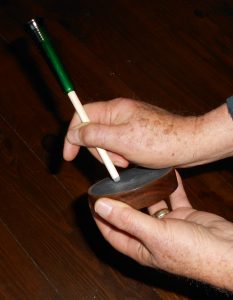When you dissect a yelp, you find that it is made up of a high-pitched “kee” note that breaks over sharply into a sound best described as a “youk”. When you put the two sounds together you get a “kee-youk”.
You should be familiar with all yelp sequences so you will be sure you are sending the right message at the right time.
The first note in the yelp is the whistle sound, called a “kee”. When turkeys are very young, they can manage only the first half of the yelp, so the first calling sound is a plain kee-kee or poult whistle. The young turkeys’ ‘lost’ calls are plaintive and leading, and pure and clear.
Young poult whistles are the most musical bird calls I’ve ever heard. The whistles are usually done in groups of three — kee-kee-kee — and repeated every 30 seconds or so until contact is made with the family flock.
When the poults get a little older their whistle gets a little coarser and the young turkeys start trying to add a “youk” to the “kee” to make a complete yelp. The young hens whistle two or three times to build up to a yelp, then they yelp a time or two. When they are able to get that done, the sequence is called a kee-kee-run. Young gobblers sometimes gargle out an attempt at a yelp before they whistle, then yelp two or three times after the whistle.
As turkeys mature, they usually drop the pre-yelp whistles, but turkeys can do whatever they want, so it isn’t unusual to hear adult hens doing kee-kee-runs in the spring.
If you do any Fall hunting, the kee-kee-run is a “must learn” since it is the poult’s ‘lost’ call and the one they are most likely to respond to. I have also been successful using kee-kee runs in the Spring. On several occasions I have been able to get gobblers to respond to kee-kees when they wouldn’t gobble at any of my counterfeit calls or even the yelping of a genuine hen.
I believe the kee-kees are such pure, unadulterated turkey sounds they penetrate whatever B.S. filter the turkey may have, and they gobble whether they want to or not. If turkeys aren’t talking, a kee-kee run is worth a try. You won’t alarm anything, and you just might get things stirred up.

Gary Sefton, set up and calling on a box call. He will have his face mask up when he gets serious and will have his shotgun on his left knee for quick shooting with little motion.

Gary Sefton, set up and calling on a slate call. He will have his face mask up when he gets serious and will have his shotgun on his left knee for quick shooting with little motion.

This is the angle you want for a striker on a slate call.
ASSEMBLY YELPS
When poults finally break out of their shells, they seem to be born knowing to respond to the series of distinctive yelps the brood hen makes to assemble her flock. This series of yelps is known collectively as the assembly yelp, though the term ‘yelp’, is used loosely here since most hens will add a cluck or two in front of and/or behind the yelps.
I have never heard any two hens sound alike when they are assembling their brood. I’ve heard a couple that did more clucks than yelps calling in their flock.
What distinguishes the assembly yelp from the plain or lost yelps, to me, is the unmistakable sense of authority and urgency she conveys in her calling. She is very plainly telling her poults to “get yourself over here right now!” And the poults mind very well.
Lovett Williams, an authority on turkey biology, says the poults are imprinted and conditioned to respond only to the sound of their maternal hen’s voice. It is nature’s way of keeping the poults from getting mixed up with other broods. You should know you’re not going to have much luck trying to call the poults away from her. I have, on occasion, been able to bring the hen and her brood to me by teasing and mocking the old girl with my version of assembly yelps. Try to sound just like the old hen and add a little “charisma” to your calling. However, most of the time she will just gather up her troOps and go the other way.
I don’t consider the assembly yelp to be a very useful hunting call since every hen has a different version, but you should be aware of it.
PLAIN YELPS
The plain hen yelp is what it says it is — a plain series of four to six yelps that don’t vary much in tempo, volume or intensity. No one has a clear explanation of what they exactly mean. A turkey will make plain yelps in clear sight of her flock, so they aren’t lost yelps or assembly yelps.
The plain yelp is the one sound you want to master above all others if you want to be an effective turkey caller. If a turkey won’t respond to your yelp, something is wrong with the turkey or with your yelp.
One spring season I hunted with Ron Jolly, one of the best turkey hunters I know, and an outstanding videographer. That season, he filmed 28 turkeys called to the gun. Every one of them came in to hen yelps. No response to other calls, just to hen yelps, and most of them plain hen yelps.
You can change the volume and the tempo slightly to imply excitement, but you want to be sure to keep the sequences short and crisp and clean, four to six yelps.
I think it is of utmost importance to make a statement when you call. I have always believed making turkey sounds with no purpose or sequence was counterproductive.
A turkey biologist named Joe Hutto raised and reared a group of wild turkeys that he incubated, hatched and then imprinted on himself. He literally became one of them as their surrogate mother to observe their behavior up close through their first year of life. He opened a natural window into their emotional and mental processes that was untainted by the usual fear and distrust of humans.
I believe his findings are invaluable. One observation dealt with the sounds that distressed and disturbed turkeys make. He said, “One way to frighten or disturb wild turkeys, ironically, is with a turkey call. They seem very limited in their tolerance for meaningless yelping.”
Therefore, when you make a call, know what you’re saying and how to say it. Make a statement and say it with some authority.
For more turkey calling and hunting tips, order Lessons Learned From the Magnificent Bird, by Gary Sefton.

You want a big gobbler puffed up and displaying, within good shotgun range and unaware of you.

When everything goes right, you should get a photo like this.

